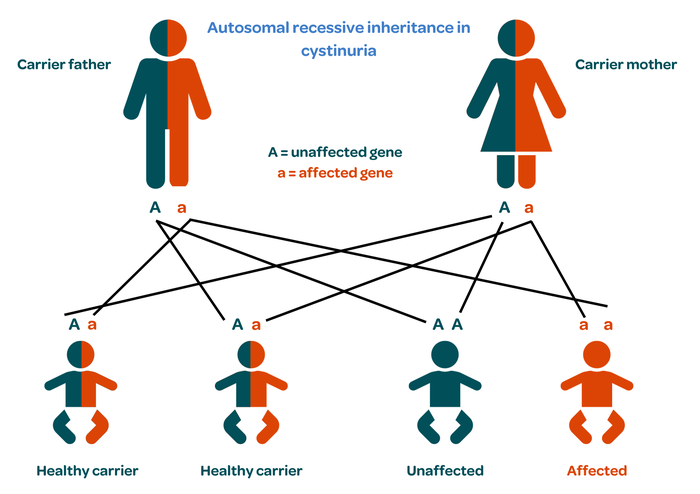What is cystinuria?
Cystinuria is an inherited kidney condition that causes problems with the transportation of an amino acid (a building block of protein) called cystine. Cystine builds up in the urine to form crystals, which can eventually turn into kidney stones. Repeated kidney stones can cause damage to the kidneys themselves and eventually lead to kidney failure, although this is rare.
Cystinuria is thought to affect around 1 in 2,000 people in the UK, although many people may be undiagnosed as they do not have any symptoms. Although kidney stones themselves are common, only 1% of stones in adults are due to cystinuria.
Cystinuria is more common in people from a White background and although men and women are equally likely to be affected, men tend to have a more severe form of the condition.
Note: Cystinuria is a different condition to cystinosis.
What are the signs and symptoms of cystinuria?
Young children with cystinuria may be very floppy, with poor muscle strength (hypotonia) and reduced growth. They may also have excessive hunger, which leads to weight gain.
In older children and adults, the most common symptoms of cystinuria are related to kidney stones. These include pain in the lower back or groin (renal colic), which can come and go in waves and range from mild to severe.
Urinary tract infections (UTIs), which may cause pain while passing urine (dysuria), are also common.
The number and size of kidney stones vary. Some people have only a few stones in a lifetime and few symptoms, while others get several new stones a year.
What causes cystinuria?
Cystinuria is caused by a problem with how the body transports the amino acid cystine, as well as other amino acids such as ornithine, arginine and lysine. The kidneys process the blood and remove waste products in the urine. Cystine is a waste product that should be removed but a genetic fault in people with cystinuria means that, instead, it builds up to form crystals and eventually, kidney stones.
How is cystinuria diagnosed?
Cystinuria is usually diagnosed by examining a kidney stone that has been passed or removed from the body, to see if it is made up of cystine. A urine test can also be used if a stone is not available, as there will be high levels of cystine and other amino acids in the urine.
A blood test may be used to check the function of the kidneys and/or a urine test to look for any signs of kidney damage.
Cystinuria is usually diagnosed in early adulthood, although kidney stones may have been present for several years before a diagnosis is made.
Genetic testing may be offered if there is a history of the condition or if the kidney stones occur in young children.
Does cystinuria affect other parts of the body?
Cystinuria only affects the kidneys.
Does cystinuria run in families?
Cystinuria is an inherited condition so it can run in families. It is caused by a change or mutation in one of two genes, SLC3A1 or SLC7A9. It is usually inherited when both parents pass on a copy of the faulty gene.
Everybody has two copies of these genes, one from each parent.
Healthy people have two normal copies.
Carriers have one copy that works normally and one that doesn’t. Carriers are usually healthy because the normal copy can still do its job. However, they can still pass cystinuria on to their child.
In people with cystinuria, neither copy of the gene works properly.
When both parents are carriers, a child could be healthy with two normal genes; a healthy carrier like their parents, with one healthy and one faulty gene; or affected, with both genes being faulty. This pattern is called autosomal recessive inheritance.
Rarely, just one copy of the faulty gene is enough to cause cystinuria. In this case, a person with cystinuria has a one in two chance of passing the condition onto their child.
It is not currently known why there is a difference in inheritance patterns or why some people with cystinuria form stones and others don’t.

How is cystinuria treated?
There is currently no specific treatment for cystinuria, so the focus is on keeping cystine dissolved in the urine so that it doesn’t form crystals that build up to form stones. This can be helped by:
- keeping the urine dilute by drinking lots of water (four to five litres a day) and reducing salt intake.
- making the urine slightly alkaline to help the cystine dissolve. This can be done by reducing the amount of meat and dairy products and by increasing the amount of fruit and vegetables in the diet. Alkali medications may also be prescribed.
- chelating medications, such as penicillamine. These may be prescribed if stones continue to form. They work by binding to the surface of a cystine crystal to stop more cystine from building on it and turning into a stone.
Special recipe books for people with cystinuria have been produced by Guy's & St Thomas’ Hospital. Dietary changes should only be undertaken on the recommendation of and monitoring by a specialist kidney dietitian.
Small kidney stones can be passed in the urine with little or no pain, and may only require monitoring with an ultrasound scans to check their location. However, large stones may require surgery, especially if they are at risk of causing blockages in the kidney and leading to long-term damage.
There are various ways that stones can be removed depending on their size and location:
- Lithotripsy – uses sound waves to break the stones into smaller pieces that can then be passed in the urine.
- Endoscopy – involves passing a flexible fibre optic ‘telescope’ called an endoscope up the urinary system to see the stone directly. Special tools built into the endoscope are used to capture or break up the stone.
- Open surgery – to remove stones is rarely needed.
Kidney damage can be reduced by maintaining a healthy lifestyle. For example:
- Avoid smoking. Smoking damages the blood vessels in the kidneys and speeds up kidney damage.
- Control blood pressure. High blood pressure damages the kidneys and increases the risk of stroke and heart disease. Blood pressure should therefore be checked regularly. This can be done at home with a blood pressure machine from a chemist.
- Eat a balanced diet. It is especially important to limit the amount of salt in the diet as too much salt can cause high blood pressure.
- Exercise regularly. This can help to control blood pressure.
If kidney failure occurs, dialysis or transplantation will be needed but this is very rare. If a transplant is needed, cystinuria will not reoccur in the new kidney.
Most people with cystinuria can live normal lives but will require regular monitoring to prevent any complications.
Where can I get more information or support about cystinuria?
For more information on cystinuria, including its genetics, diagnosis, symptoms and treatment, visit Cystinuria UK.

Publication date: 11/2023
Review date: 11/2026
This resource was produced according to PIF TICK standards. PIF TICK is the UK’s only assessed quality mark for print and online health and care information. Kidney Care UK is PIF TICK accredited.